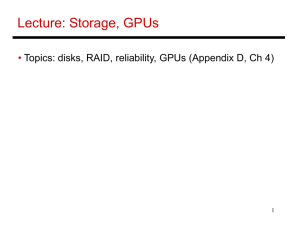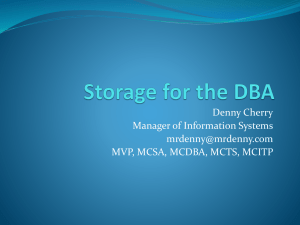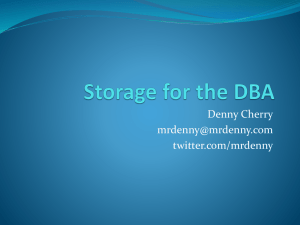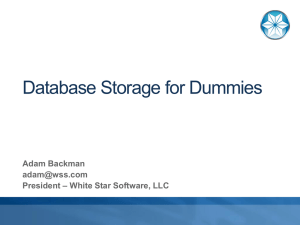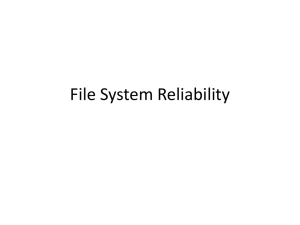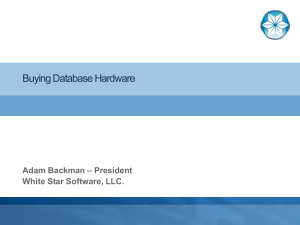Lecture 11: Storage Systems
advertisement
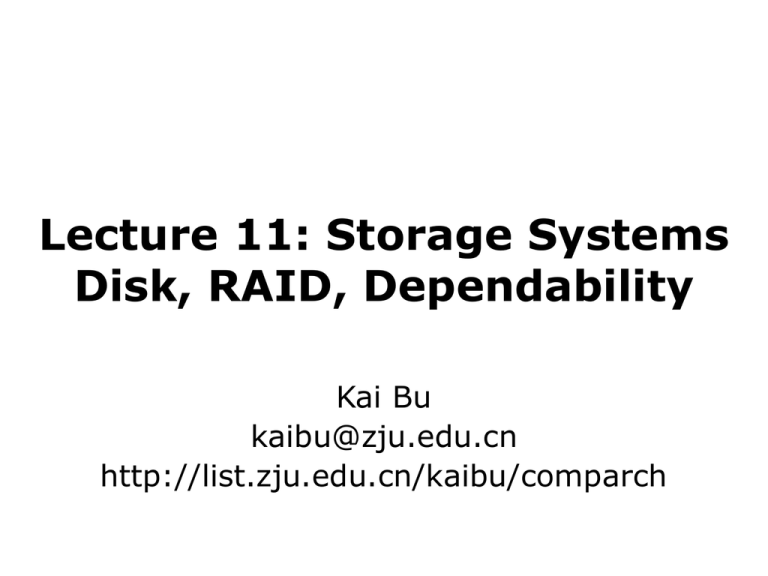
Lecture 11: Storage Systems Disk, RAID, Dependability Kai Bu kaibu@zju.edu.cn http://list.zju.edu.cn/kaibu/comparch Lab 3 Demo due Report due May 20 Assignment 3 due Lab 4 Demo due May 20 Report due May 27 PhD Positions in HK PolyU http://www.cc98.org/dispbbs.asp?boardid=68&id=4373185&star=1#1 Appendix D.1–D.3 1960s – 1980s Computing Revolution 1990 – Information Age Communication Computation Storage Communication Computation Storage Communication Computation Storage requires higher standard of dependability than the rest of the computer program crash Communication Computation Storage requires higher standard of dependability than the rest of the computer Communication Computation data loss Storage requires higher standard of dependability than the rest of the computer Communication Storage magnetic disks dominate Outline • Disk • Disk Array: RAID • Dependability: Fault, Error, Failure Outline • Disk • Disk Array: RAID • Dependability: Fault, Error, Failure Disk http://cf.ydcdn.net/1.0.1.19/images/computer/MAGDISK.GIF Disk http://www.cs.uic.edu/~jbell/CourseNotes/OperatingSystems/images/Chapter10/10_01_DiskMechanism.jpg Disk Capacity • Areal Density =bits/inch2 =(tracks/inch) x (bits-per-track/inch) Disk Capacity • Areal Density in 2011, the highest density 400 billion bits per square inch • Costs per gigabyte between 1983 and 2011, improved by almost a factor of 1,000,000 Disk for Secondary Storage Cost DRAM >> DISK Access time DRAM << DISK Disk’s Competitor • Flash Memory non-volatile semiconductor memory; same bandwidth as disks; 100 to 1000 times faster; 15 to 25 times higher cost/gigabyte; • Wear out limited to 1 million writes • Popular in cell phones, but not in desktop and server Disk Power • Power by disk motor ≈Diameter4.6 x RPM2.8 x No. of platters RPM: Revolutions Per Minute rotation speed • Smaller patters, slower rotation, and fewer platters reduce disk motor power Disk Power Outline • Disk • Disk Array: RAID • Dependability: Fault, Error, Failure Disk Arrays • Disk arrays with redundant disks to tolerate faults • If a single disk fails, the lost information is reconstructed from redundant information • Striping: simply spreading data over multiple disks • RAID: redundant array of inexpensive/independent disks RAID RAID 0 • JBOD: just a bunch of disks • No redundancy • No failure tolerated • Measuring stick for other RAID levels in terms of cost, performance, and dependability RAID 1 • Mirroring or Shadowing • Two copies for every piece of data • one logical write = two physical writes • 100% capacity/space overhead http://www.petemarovichimages.com/wp-content/uploads/2013/11/RAID1.jpg https://www.icc-usa.com/content/raid-calculator/raid-0-1.png RAID 2 • http://www.acnc.com/raidedu/2 • Each bit of data word is written to a data disk drive • Each data word has its (Hamming Code) ECC word recorded on the ECC disks • On read, the ECC code verifies correct data or corrects single disks errors RAID 3 • http://www.acnc.com/raidedu/3 • Data striped over all data disks • Parity of a stripe to parity disk • Require at least 3 disks to implement RAID 3 • Even Parity parity bit makes the # of 1 even 1 • p = sum(data1) mod 0 2 1 • Recovery 0 if a disk fails, 0 “subtract” good data0 1 from good blocks; 1 what remains is missing P 1 1 0 0 1 1 0 1 data; 1 0 1 0 0 0 1 1 1 1 0 0 1 1 0 1 RAID 4 • http://www.acnc.com/raidedu/4 • Favor small accesses • Allows each disk to perform independent reads, using sectors’ own error checking RAID 5 • http://www.acnc.com/raidedu/5 • Distributes the parity info across all disks in the array • Removes the bottleneck of a single parity disk as RAID 3 and RAID 4 RAID 6: Row-diagonal Parity • RAID-DP Recover from two failures xor row: 00+11+22+33=r4 diagonal: 01+11+31+r1=d1 Double-Failure Recovery Double-Failure Recovery Double-Failure Recovery Double-Failure Recovery Double-Failure Recovery Double-Failure Recovery Double-Failure Recovery Double-Failure Recovery Double-Failure Recovery RAID: Further Readings • Raid Types – Classifications BytePile.com https://www.icc-usa.com/content/raidcalculator/raid-0-1.png • RAID JetStor http://www.acnc.com/raidedu/0 Outline • Disk • Disk Array: RAID • Dependability: Fault, Error, Failure • Computer system dependability is the quality of delivered service such that reliance can justifiably be placed on this service. • The service delivered by a system is its observed actual behavior as perceived by other system(s) interacting with this system’s users. • Each module also has an ideal specified behavior, where a service specification is an agreed description of the expected behavior. Failure • A system failure occurs when the actual behavior deviates from the specified behavior. Error, Fault • The failure occurred because of an error, a defect in that module. • The cause of an error is a fault. • When a fault occurs, it creates a latent error, which becomes effective when it is activated; • When the error actually affects the delivered service, a failure occurs. Fault, Error, Failure • A fault creates one or more latent errors • Either an effective error is a formerly latent error in that component or it has propagated from another error in that component or from else where • A component failure occurs when the error affects the delivered service Categories of Faults by Cause • Hardware faults failed devices • Design faults usually in software design; occasionally in hardware design; • Operation faults mistakes by operations and maintenance personnel; • Environmental faults fire, flood, earthquake, power failure, sabotage; Categories of Faults by Duration • Transient faults exist for a limited time and are not recurring; • Intermittent faults cause a system to oscillate between faulty and fault-free operation • Permanent faults do not correct themselves with the passing of time; Example: Berkeley’s Tertiary Disk Example: Tandem Example: Tandem ?

